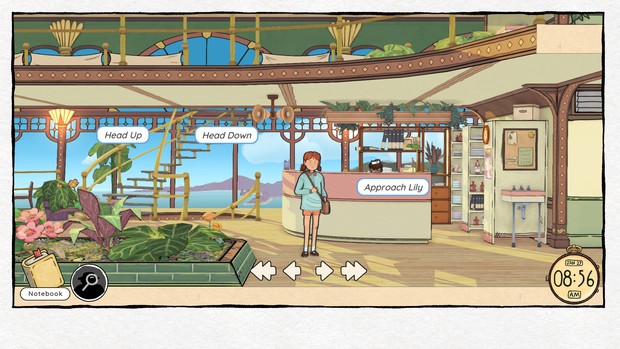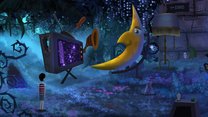Wayward Strand review – Charming narrative adventure sure to leave you feeling better

- 0 Comments
Many cultures see the young as the most important generation, all too willing to dismiss the elderly as out of touch or even an inconvenience. It’s a flawed view, of course – those with decades of life experience have fonts of wisdom to impart and stories to tell. It’s certainly not common for the aged to be the focus of video games, but indie developer Ghost Pattern seeks to break with convention in their debut adventure, Wayward Strand. It’s a small-scale, character-led game that brims with heart and charm, a shining example of the power of interactive fiction. That said, it won’t be for everyone, nixing puzzles and inventory in a favour of something that can be intentionally quite passive. If you’re okay with that, Wayward Strand will provide a special and thoughtful journey that should have different meanings to people of all ages.
Set in 1978 Australia, the game stars Casey Beaumaris, a young girl on school break who is roped into helping out for three days aboard the airship hospital where her mother works as the head nurse. Casey is a shy child with a serious face, often clutching her satchel strap and feeling far more relaxed with her head in a book than talking to strangers. As you might imagine, she isn’t enthralled by the prospect of spending her valuable free time in the company of old folk. Casey decides to use the opportunity as the basis of a report for her school newspaper, finding out what she can about the history of the hospital and its residents.
This isn’t an ordinary hospital – it’s in a moored blimp, for starters, a fact you have to roll with – but is rather more like a care home. Aboard are the staff and patients from all walks of life, each with distinct and believable personalities. The characters of many games feel like they exist in service of the protagonist, standing around waiting for you to interact with them. In Wayward Strand, everyone goes about their lives whether you get involved or not. The residents meet for lunch, gossip in each other’s rooms, or admire the aerial view. Everything plays out across three in-game days, with an on-screen clock ticking until Casey’s mum finishes work and the pair travel home. It’s up to you to decide where to go and who to talk to, as the world doesn’t stand still in your absence. While you may choose to hang out at the nurse’s station, that could mean you miss some drama happening in a patient’s room.

As someone who likes to hear every line of dialogue, this was hard for me get to grips with at first, but it’s ultimately one of the main factors that makes Wayward Strand so rewarding. Choosing who to invest your valuable minutes with shapes the dynamics of the story and your relationship with those in it. Take Heinrich Pruess, for example, a slow-speaking Austrian with a funky tie. He’s like an onion whose layers you can slowly peel back; doing so rewards you with him opening up about his past and his family, but you may never encounter this in your playthrough. Instead you might find him to be polite but distant if you prioritise visits to the kindly knitter Ida Vaughan, a tea-sipping grandma who recently lost a friend and invites your questions.
If you wish, you can opt to spread your time thinly between everyone, including the non-verbal plant lover Tomi Hummel, the renowned author Neil Avery, and the jovial but overworked nurse Lily. You’ll likely want to interact with these people as much as possible because it’s enjoyable to find out more about them, each with their own eccentricities, but it’s entirely your choice. If you decide to, you could spend all three days in the room of Margot Bouchard, a grumpy, mostly bedbound former doctor who makes it very clear that she doesn’t welcome your presence – you might find that an awkward experience, though!
Often you don’t need to actively participate in the goings-on in the airship to benefit from them. You’ll find it valuable even just listening in on conversations from the sidelines where others aren’t aware of your presence. (While sometimes you’ll get called out if you’re caught snooping, folk generally pay you no notice.) You might catch Mr. Avery and the spiritual Esther Fitzgerald speculating about a mystery visitor in town, the staff quietly discussing a patient’s critical condition, or simply overhear a mundane yet charming exchange as shuttle operator Ted reads Heinrich the newspaper headlines. Immersing yourself in the happenings of the hospital is a delight. This is pure slice-of-life fiction, and the experience is all the better for it.
Dialogue options are informed by the objects you’ve examined or titbits you’ve overheard. You might notice Tomi’s golden bear statues in her room, or discover that a nurse suddenly quit without warning; you can then probe others to find out what they know, piecing together strands to form a bigger picture. Sometimes the choices are limited, though, which is disappointing; you never get the chance to follow up on interesting moments, or you end up asking multiple people about the same specific thing. You can also choose to sit in silence and soak up the atmosphere; your companion may make a comment or pose a question to Casey, rewarding your patience, but sometimes no-one says anything. This can feel natural – a comfortable silence, like sitting and listening to music with Mr. Pruess – but every so often it’s stilted, such as in a group setting where conversation suddenly dies. Occasionally you’ll notice characters standing around awkwardly, as if waiting for a trigger, but this is uncommon.

It’s easy to overlook such issues because of how great the writing is. The script seems incredibly authentic, successfully capturing the many different personalities without relying on clichés, and believably reflecting how humans actually talk to one another – with all the clumsiness that entails. People are complex, not boiled down to single personality traits, and that’s portrayed well here. There’s plenty of humour throughout Wayward Strand, like when Casey’s hesitation causes Esther to mistake her name as Umcasey, but it also touches on heavy themes like death and loneliness. And yet it never feels morose, in part thanks to Casey’s wide-eyed innocence. On the contrary, I found it incredibly uplifting and comforting, like being curled up by the fire with a good book.
The music and art also play a big part in creating this sense of cosiness, with gentle tunes accompanying your stay aboard the ship. Strings lightly twang away in the background, with a custom piece for every resident’s room, establishing a calm ambiance that perfectly suits the pace of the game, though you might find the tracks get repetitive eventually.
The hospital blends a nice variety of functional and regal architecture, with all three floors being a pleasure to visit. For instance, the middle deck plays host to the dining room – a key meeting spot at lunchtime – with its ornate hanging chandelier, grand piano, and huge windows looking out over the bay. It’s easy to understand why Mr. Pruess is often stationed there! Throughout the ship, the bedrooms are decorated according to each occupant’s taste and display trinkets from their life: Joni’s is swamped with plants, Esther has a crystal ball right in the centre, and Dr Bouchard has only a few books and her packed bags. These personalised decors are a quick and handy way of getting insight into the patients’ lives.
Wayward Strand employs an attractive hand-drawn graphical style, with bright colours and black outlines that lend an almost comic book aesthetic. This is furthered by the third-person perspective that displays a cross-section of the ship and makes you feel like you’re hopping between comic panels when you move around. This format allows you to see and hear action occurring on the periphery, enticing you to investigate the surrounding scenes. As you enter a room, the camera zooms in and the walls fade away, offering a more intimate setting. A similar effect happens when you engage with someone in the corridors or eavesdrop, with the camera swinging into a different fixed position – always in a single motion, with no cuts, to maintain that real-time feel. There are plenty of windows throughout the ship, perfect for showing off the changing weather outside. The skies are vibrantly blue on your first day, bathing the interiors with a happy energy. The next day brings dark clouds and rain, but the warm glow of the ship lights maintains the cosy, comfortable feeling.

Slightly tarnishing the visual splendour are the semi-regular small graphical glitches, as characters tend to clip through objects and one another. They can also look wooden in motion, like turning in place before walking, or when animations don’t smoothly transition, such as when Felix the hospital director goes from shuffling papers to talking on the phone at his desk and you can distinctly see each cycle kick in. I found that the pleasing art style (and indeed the rest of the game’s many strengths) allowed me to forgive the occasional awkward animation. Still, it’s the area where Wayward Strand’s presumably humble budget lets the side down somewhat.
There was clearly no skimping on voice-overs, as the hospital staff and its residents – each visually distinct and immediately recognisable – are all wonderfully brought to life by an eclectic mix of actors. There’s not a single dud. Whether it’s Mr. Avery’s self-grandeur, nurse Joe’s apathy, or Felix’s bombast, each actor infuses their role with a real sense of personality without turning them into caricatures. The same goes for Casey, whose voice wonderfully conveys her soft, thoughtful spirit. The lines flow naturally, making the characters feel like genuine people as a result. Plus, with a cast made up nearly entirely of Australians, the accents and actors are atypical from those we normally hear in video games, further contributing to Wayward Strand’s distinctive allure.
There isn’t much in the way of gameplay here, but Casey jots into her notebook as she goes, keeping track of details both big (a VIP is due to visit the hospital) and small (Ted eats cereal), and you can refer to it at any time. The entries are snappy and informative, believably belonging to a 14-year-old wannabe journalist. Each character has their own section, which makes for a handy recap, and some notes function as hints for where you might want to be later in the day – for example, that you overheard Dr Bouchard unusually plans to be in the cafeteria at lunch. Adorable doodles accompany some pages, which adds to the enjoyment of flicking through the notebook.
It’s worth mentioning Wayward Strand’s control scheme, which is simple to master and offers a choice of methods to suit your preference between a gamepad, keyboard, or mouse (or a combination of the latter two). Casey’s movement is essentially on rails since she follows a fixed path, so you control the direction of her travel and select action prompts (which appear in bubbles, like entering a room or using the stairs) and dialogue.
Each game day lasts around an hour and a half. The pacing is perfect because it always left me satisfied yet still wanting more, but there’s a technical constraint to be aware of: no manual saving. Your progress is automatically saved at the end of each day, and that’s it. This may help in forcing you to commit to your decisions, but if you’re unable to devote the full chunk of time to a gaming session, it may pose a problem. It’s a frustrating omission, though Ghost Pattern says they are working on improving the save system, so hopefully this won’t continue to be an issue.
You might think Wayward Strand’s design encourages repeat plays so you can see what you missed – and in a way, that’s true. After all, it’s impossible to see everything on your first go-round. My first time through, I uncovered a secret area that led to a handful of interesting encounters. I didn’t go there on my second playthrough, but I did end up having fulfilling chats with someone I wasn’t even aware you could interact with before. I was also able to witness events first-hand that I’d only heard murmurs of to that point, which was lovely. However, the broad strokes remain the same, and it almost took away some of the magic, like I’d peered behind the curtain. This isn’t a criticism, just an observation. I’m undecided if the value gained from my new discoveries was worth it. If you do want to play Wayward Strand multiple times, I’d suggest waiting until your original memories get a bit hazy.
Final Verdict
Wayward Strand is a game that will surely stick with you, in great part due to the unique setting and its brilliantly constructed occupants. It’s not a spoiler to say that there is no grand ending – life goes on – but that makes it all the better, giving you room to ponder what the likes of Mr. Pruess, Ida, and Ted are getting up to after you’re gone. There are a few flaws, namely some dodgy animations and lack of manual saves (at least at time of writing), but they don’t detract from what is ultimately a joyous character drama. If you can handle the unapologetically relaxed pace and the lack of any puzzles, the game will reward you greatly with its emphasis on the benefits of listening and empathy. It doesn’t hold your hand or force you along a certain route. Where you go, who you talk to, and what you say is up to you, and it’s a sweet reminder to value those that society may be quick to cast aside yet still have so much to share. All aboard.
Hot take
With buckets of charm and heart, Wayward Strand’s floating hospital for the elderly will delight you with its unusual real-time gameplay and exceptionally well-written characters.
Pros
- Genuine player agency has real-time consequences
- Realistic writing excels in presenting a cast of lovely characters
- Great voice acting
- Cosy and colourful hand-drawn aesthetic
Cons
- Some graphical glitches
- Occasional stilted moments of silence
- No mid-chapter saving (for now)
Joe played Wayward Strand on PC using a review code provided by the game's publisher.

- Advertisement
- Help support AGH by advertising with us










0 Comments
Want to join the discussion? Leave a comment as guest, sign in or register.
Leave a comment